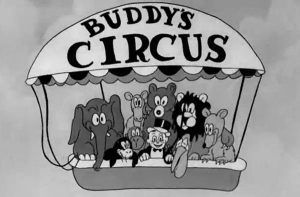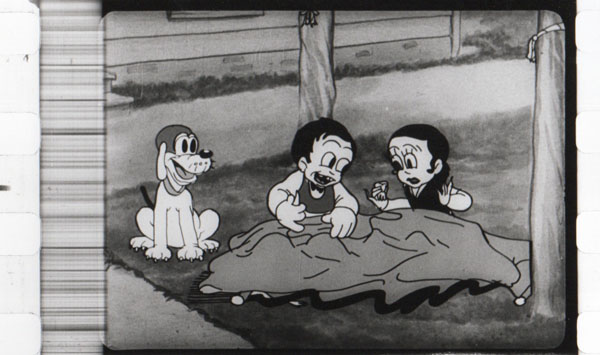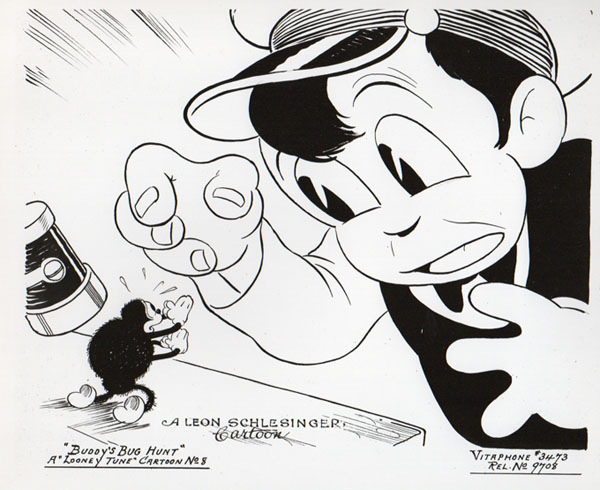 During the 1934-35 season, Warner found a new way of introducing their movies. They began throwing their shield (as well as a shield for First National Pictures) at the audience out of a bank of clouds. I wonder how many children were “spooked out” by this new intro.
During the 1934-35 season, Warner found a new way of introducing their movies. They began throwing their shield (as well as a shield for First National Pictures) at the audience out of a bank of clouds. I wonder how many children were “spooked out” by this new intro.
The film industry was also now expected to display a shield which would indicate that this picture was approved by the Motion Picture Producers and Distributors of America (MPPDA). This seal meant the picture passed muster under the now enforced Code under which the film industry was to operate. Unfortunately, commonly available prints of the titles which follow (which themselves are not very common) are rarely seen with their shields remaining intact.
Buddy the Detective (10/17/34) – Buddy tries to save Cookie from “The Mad Musician”, who absolutely despises jazz music. Soundtrack includes snatches of Rachmaninoff’s “Prelude in C Sharp Minor”. None of the popular tunes of the day are featured, except for a little of “Shake Your Powder Puff”, discussed in a previous article.
Buddy the Woodsman (10/20/34) – A standard collection of lumberjack gags. Songs include “I’ll String Along With You”, a song from Twenty Million Sweethearts (embed below), and an original song sunh by a chorus of lumberjacks, “The Old Northwest”. “I’ll String Along” was recorded by Tom Coakley, an orchestra from the Palace Hotel in San Francisco, on Victor, while Melotone and the dime store labels had a version by Smith Ballew and his Orchestra (primarily a Victor Young studio band).
 Buddy’s Circus (11/6/34) – Fairly standard collection of circus gags, including a lion that gets loose and imperils everybody, as well as a gag regarding a “Ubangi” whose lips are so wide that he can house within them a “Ubangiphone” record player. The song heard when the player is playing is “Why Do I Dream Those Dreams?”, discussed before.
Buddy’s Circus (11/6/34) – Fairly standard collection of circus gags, including a lion that gets loose and imperils everybody, as well as a gag regarding a “Ubangi” whose lips are so wide that he can house within them a “Ubangiphone” record player. The song heard when the player is playing is “Why Do I Dream Those Dreams?”, discussed before.
Buddy’s Adventures (11/17/34) Buddy and Cookie wind up in “Sour Town”, where dancing and music are forbidden. No particular pop song featured – instead, an original “talk song”, “Life Is Just a Bowl of Lemons”, a parody on “Life is Just a Bowl of Cherries” from the broadway show “George White’s Scandals of 1931″. This film could be compared to Van Buren/Ted Eshbaugh’s cult classic, “The Sunshine Makers”.
Viva Buddy (12/12/34) – Buddy in old Mexico, getting involved with a bandito leader inspired by a recent MGM release, “Viva Villa”. Song featured is “Monterey”, whose sources and composers are as yet unknown to this author.
Buddy the Dentist (12/15/34) – Also no particular pop song featured. Buddy’s dog Towser has a toothache, with Buddy trying to make an extraction.

A frame from a 35mm nitrate print of BUDDY THE DENTIST
Buddy’s Pony Express (3/19/35) – Featured song is an original, “Oklahoma Cowboy Joe”. Standard Western with Buddy vying for a contract for a pony express run.
Buddy’s Theatre (4/1/35) – Buddy operates a motion picture theatre – does not repeat any gags from “Bosko’s Picture Show”. Songs include the old sailor song,”Nancy Lee”, “Mr, and Mrs. Is the Name” from “Flirtation Walk”, and what may be an original, “How High Can a Little Bird Fly?”. “Mr and Mrs.” was recorded by Dick Powell for Brunswick with a studio band, probably under Russ Morgan’s direction. Victor Young recorded it for the new Decca label.
Buddy of the Legion (4/6/35) – Buddy finds himself a job in a book store, and winds up daydreaming while reading a book on the French Foreign Legion. He attempts in his dream to rescue a regiment from a squad of amazon women – but awakes to get canned from his job. Songs include “Congratulate Me”, recorded for Decca by Johnny Davis (later known as Johnny “Scat” Davis) and his orchestra, and which later became quite popular with Texas “Western Swing” bands, recorded by W. Lee O’Daniel and his Hillbilly Boys on Vocalion. There is also what may be an original song, “Out in Old Arabia”.
Buddy’s Lost World (5/15/35) – Buddy takes an expedition to an island populated by dinosaurs. Songs include “Lullaby of Broadway” from “Golddiggers of 1935″. This song was recorded by Hal Kemp for Brunswick, and by Richard Himber for Victor. Decca gave it as a vocal record to Wini Shaw, who introduced it in the film. Columbia royal blue gave it to Johnny Green and his Orchestra.
Buddy’s Bug Hunt (6/22/35) features what appears to be an original number, “We’ve Gort You Where We Want You”. Buddy is trying to collect insects, and is shrunk and put on trial by the bugs he’s collected, who give him “the works”, including a spanking machine.

Buddy In Africa (7/6/35) gives a great concentration to a song called “Love in My Heart”, of which I know of no commercial recordings. One of the “notorious” Buddy episodes for heavy use of stereotyped Africans.
Buddy Steps Out (7/20/35) – Buddy and Cookie go off on a date, while their pictures are getting together at Buddy’‘s apartment. Songs include “About a Quarter to Nine”, introduced by Al Jolson in Go Into Your Dance, as well as the evergreen, “Avalon”. “Quarter to Nine” was recorded by Litlle Jack Little on royal blue Columbia, Jack Shilkret on Bluebird with an anonymous vocal by Dick Robertson, and Chick Bullock on Melotone and the dime store labels.
Buddy the Gee Man (8/24/35) – Buddy goes to prison to investigate charges that the warden is treating his prisoners badly. Buddy finds out the truth, and becomes warden himself as his reward, leading the cons to want to break into prison to receive the special treatment Buddy is offering. Songs include “Lulu’s Back in Town” (introduced by Dick Powell in Broadway Gondolier and recorded by him on Brunswick, and also recorded by Fats Waller on Victor), and “She’s a Latin From Manhattan” another hit from Al Jolson in Go Into Your Dance. “Latin” appeared as the flip side of the Litlle Jack Little Columbia of “About a Quarter to Nine” mentioned above. Chick Bullock also got the number on Melotone and the dime store labels.
Merry Christmas Everybody! Next Time: The Merrie Melodies from 1934-35.


 James Parten has overcome a congenital visual disability to be acknowledged as an expert on the early history of recorded sound. He has a Broadcasting Certificate (Radio Option) from Los Angeles Valley College, class of 1999. He has also been a fan of animated cartoons since childhood.
James Parten has overcome a congenital visual disability to be acknowledged as an expert on the early history of recorded sound. He has a Broadcasting Certificate (Radio Option) from Los Angeles Valley College, class of 1999. He has also been a fan of animated cartoons since childhood.











































Seeing Sergei Rachmaninoff and Fats Waller in the same post reminds me of a story one of my professors told me years ago about the time the two legendary pianists met in person. Fats was a huge man, but the lanky Russian towered over him, prompting him to remark (if memory serves): “Oh my goodness, who chopped down the beanstalk?” Rachmaninoff took offence and stormed off without a word. However, this story does not appear in the biographies of Rachmaninoff and Waller that I’ve read, and I strongly suspect that it may be apocryphal.
Rachmaninoff composed his Prelude in C-sharp Minor when he was nineteen, and for the rest of his life audiences would clamour to hear it as an encore, to the point where he got thoroughly sick of it. Harpo Marx, in his autobiography, tells of the time he was staying in a hotel where someone was practising piano loudly in the next room; and when he learned that the pianist was the famous Rachmaninoff, he began to play the Prelude on his harp, having learned it for a scene in “A Day at the Races”. He had no idea how much Rachmaninoff hated that piece. Instead of coming over to say hello, the humourless and hypersensitive composer rang up the concierge and demanded another room!
There is a novelty jazz arrangement of the Prelude called “The Russian Rag”. I played it in a ragtime band in the nineties, though it didn’t remain in our repertoire for long (C-sharp minor is kind of an awkward key for jazz). I can’t imagine the dour Rachmaninoff, who was described as “six and a half feet of scowl,” liking it any more than the Mad Musician would have.
“Buddy the Detective” is quite an enjoyable cartoon, despite the star not appearing until over halfway through (or perhaps because of this). The Mad Musician should have tried hypnotising Cookie with the magic words “Dunk-a hunk-a lunk-a!” It worked on Betty Boop in “Out of the Inkwell”.
Maybe that’s why Buddy was considered so bland and boring compared to Bosko. Very few popular songs compared to what came before and after.
Merry Christmas!
Fantastic coverage of all the songs found in these great cartoons, but there is a s ong that needs to be identified…and I just hope I get all the details correct here…the tune appears near the close of “BUDDY THE DETECTIVE”, as the classical piece ominously played on the piano at the insistance of the “Mad Musician” suddenly turns into a little jazzy number. That jazzy number is revisited in something actually performed by Buddy, with lyrics, but existing prints on the internet make it hard for me to determine just what they are. This little ditty is probably what gets Buddy and Cookie in dutch with the leader of this sour other world. If anyone knows what this song is called, I’d really like to know, and I sincerely hoped that this column would have solved that problem for me. My assumption that this must have been a very little-known popular song came because it appears in at least two of these BUDDY cartoons that I know of. I’m sure that I hadn’t heard it in any of the MERRIE MELODIES of the period or previous to it. Everyone have a wonderful Holiday Season, and here’s hoping that Cartoon Research has much good things and bits of history to continue reporting, along with nice prints of the cartoons talked about!! Happy, happy, joy, joy!!
Oops, I didn’t identify the cartoon in which the jazzy number is revisited with lyrics. I’m talking about the little tune performed in “BUDDY’S ADVENTURE” that gets Buddy in dangerous trouble with the “king”(?) of this sour planet that they drift off to. So, to clarify, the tune appears first near the close of “BUDDY THE DETECTIVE” and again in “BUDDY’S ADVENTURE”. Sorry about that, folks; in all the Christmas rush, I forgot that most important notation. Hope the tune can be identified. From what I can make out, the lyric sings about a “sailor boy in blue” who is a real “ladies’ man”, if that gives you any idea. I’d love to hear a fully restored version of this cartoon to see if I could hear the tune more clearly…maybe someday??
The song you are looking for is called HEY! SAILOR (written by Sammy Fain and Irving Kahal) and it was written for the 1934 James Cagney feature HERE COMES THE NAVY (1934).
Thanks for this! I love “Hey! Sailor” and found the sheet music for it but to date have never found any release of the song. I knew about a snatch of it used in Buddy the Detective but I’ve never heard the entire song played all the way through in any film. You can hear just over a minute of an instrumental version in “The Case of the Howling Dog” when Perry Mason discovers the murder. Then there’s about 30 seconds of it in “Here Comes the Navy” when Cagney dances with his girl. It also can be heard briefly in Miss Pacific Fleet with Joan Blondell and Glenda Farrell. The bit in Buddy’s Adventures is the best arrangement and Buddy even sings some of the lyrics!
If anyone knows where I can get a copy, please post here.
How high can a little bird fly is by Dietz and Swartz and was written for the musical radio show The Gibson Family. There is a recording or two.
Man, I have LOVED this series of posts! Please keep up the great work!
In 1961, Paul Revere and the Raiders had an early hit with a takeoff on Rachmaninoff’s Prelude, “Like, Long Hair”: https://www.youtube.com/watch?v=xt9rO_otbMA
Eric Carmen’s hits “All By Myself” and “Never Gonna Fall in Love Again” swiped their melodies from Rachmaninoff.
As did Frank Sinatra’s 1945 hit song “Full Moon and Empty Arms”.
According to cue sheets dug up by Daniel Goldmark, the song that opens Viva Buddy is “Madrid” by Louis De Francesco. It’s also used under the opening titles in “Rabbit of Seville.”
BUDDY’S THEATRE has always looked to me like it had its ending reanimated before release. Cookie on screen is in danger; Buddy jumps at the screen and it collapses over him; and you can see the figures of both Buddy *and Cookie* squirming under the canvas for just a moment before Buddy alone emerges.
You get the impression they wanted the “rescued” Cookie to be brought out of the screen for a hug with her hero, then decided it was too impossible…